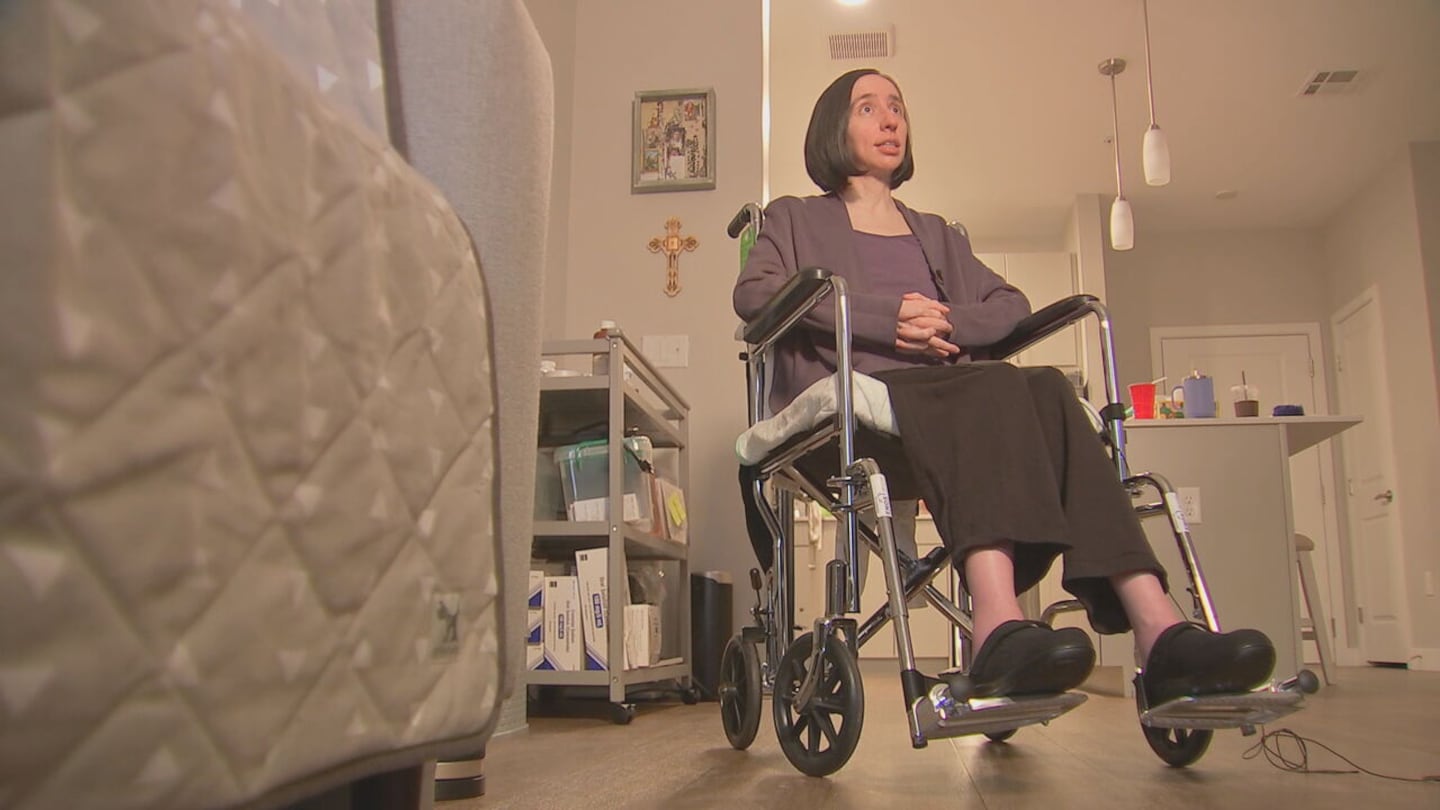BOSTON — Talia Smith, 44, of Norwood, said it felt like a “bomb went off” in her body in April 2021.
Days before that pain began, Smith had gone to the doctor suspecting a urinary tract infection.
After lab results confirmed she had a UTI, her doctor prescribed the commonly used antibiotic Cipro.
Otherwise known as ciprofloxacin, Cipro is part of a class of broad-spectrum antibiotics known as fluoroquinolones.
Its recommended uses include to treat anthrax, the plague, gonorrhea, typhoid fever, and complicated bacterial infections.
Currently, about eight name-brand fluoroquinolones are on the market – but most people are prescribed dozens of generic options.
“I actually said: ‘This is a pretty strong antibiotic,’” Smith recalled in an interview with Investigative Reporter Ted Daniel. “Like, ‘Is this the right one I should be taking? And is there anything I need to know?’ And they actually told me, ‘No, there’s nothing you need to be aware of. This is a very safe and effective antibiotic for UTIs.’”
The FDA puts a black box warning on medications that can lead to death or serious injury.
That move followed years of advocacy and lawsuits filed by people suffering after administration of fluoroquinolones.
Smith said her doctor did not inform her that the FDA has a black box warning label for Cipro and other fluoroquinolones.
The label says the class of antibiotics can cause “disabling and potentially irreversible serious adverse reactions”: including tendinitis, tendon rupture, peripheral neuropathy, and central nervous system effects. Other risks include worsening symptoms for those with myasthenia gravis. Central nervous system effects can range from nervousness, agitation, paranoia, convulsions, and dizziness to increased intracranial pressure.
The black box warning label makes clear that prescribers should prescribe antibiotics like Cipro with caution – and for uncomplicated UTIs only when no alternative treatment will work.
“Because fluoroquinolones, including CIPRO, have been associated with serious adverse reactions, reserve CIPRO XR for use in patients who have no alternative treatment options for uncomplicated urinary tract infections,” the label reads.
25 Investigates analyzed federal prescribing data and found that despite years of warning, millions of people are still receiving prescriptions for fluoroquinolones – and that it’s unclear just how many of those prescriptions are unnecessary, or how many have caused harm to patients.
‘WHAT THE HECK IS THIS?’
On a January day in her Norwood apartment, Smith recounted her harrowing journey since she took just three Cipro pills nearly three years ago.
“The third day I had stabbing pains, like in my heels, up my legs, like shooting pains, like I was getting electrocuted,” Smith said. “And I was like: ‘What the heck is this?’”
“One week I was showering myself,” she said. “The next, I was sitting in a chair showering myself. The next I couldn’t get my hands above my head.”
Five months later, she said she ended up in hospice – dropping to 65 pounds. By May 2022, she moved to palliative care and relies on a wheelchair and a round-the-clock aide.
“I worked out all the time,” she recalled of her life before April 2021. “I ate well, I was healthy, I worked, I took care of my husband. I never got sick.”
Smith has long taken care of her husband, a veteran, and quadriplegic who also relies on a wheelchair.
She said she faces symptoms from serious pain to tremors and has received a diagnosis of cell mast activation syndrome that’s left her with difficulty breathing and other ongoing symptoms of allergic reactions.
“Achilles heel, tendonitis,” Smith said, recounting her symptoms. “Neuropathy, neurological-like tremors that I still have today. Spasms. My legs kick out, nightmares, sweating, like it just goes.”
She said she has a lot of questions – including why her situation became so dire, whether taking Tylenol after Cipro worsened her symptoms, and if she was particularly vulnerable to side effects.
“I think I’m an extreme case,” Smith said.
But Smith said she should have never been prescribed Cipro in the first place… when safer antibiotics exist, and the FDA’s warning label is so clear.
‘ISSUES DOWN THE LINE’
Dr. Shira Doron, MD, Chief Infection Control Officer for Tufts Medicine, says Cipro and other fluoroquinolones can cause serious, though rare, problems.
“It has a lot of adverse consequences to use that aren’t usually immediately apparent, but create issues down the line,” she said.
“It can cause problems with the nervous system, with tendons, sometimes even with the aorta,” Doron said. “So really significant.”
“In a very aggressive manner and in a prolonged manner, they dramatically change your intestinal microbiome,” she said.
Doron says other antibiotics can treat UTIs – and without the risk of those rare issues.
The warning label also says for children younger than 18, Cipro is used “to treat complicated urinary tract and kidney infections or who may have breathed in anthrax germs, have plague or have been exposed to plague germs.”
The FDA first added a boxed warning to fluoroquinolones in 2008 for tendonitis and tendon rupture and has updated the warning throughout the years to add more possible risks. A 2013 study found the risk of tendon injury was between .08% and .2% – with a higher risk for those who are highly active.
And in 2018, the FDA published a drug safety communication about hypoglycemic coma and mental health side effects with fluoroquinolones.
“Because the risk of these serious side effects generally outweighs the benefits for patients with acute bacterial sinusitis, acute bacterial exacerbation of chronic bronchitis, and uncomplicated urinary tract infections, the FDA determined that fluoroquinolones should be reserved for use in patients with these conditions who have no alternative treatment options,” the FDA says on its website.
But Smith said her doctor never informed her of the black box warning – and says that she felt the doctor dismissed her concerns once she began to complain of adverse symptoms.
Smith said when she went to the hospital for pain and trouble walking in the days after taking Cipro, she met with another doctor.
“Then I went to the hospital, and I said, ‘I can’t walk today,’” she said. “And the doctor said, ‘Were you taking Cipro? You know, there’s a black box warning label.”
DESPITE WARNINGS, MILLIONS STILL PRESCRIBED FLUOROQUINOLONES
25 Investigates found that prescribing rates of fluoroquinolones have dropped nationwide since the FDA enhanced the warning label in 2016.
In 2014, at least 22.2 million individuals received a prescription for fluoroquinolones.
By 2022, that figure dropped to nearly 14.8 million, according to figures provided by the CDC to 25 Investigates.
- 2017: 24.6 million prescriptions
- 2018: 22.1 million prescriptions
- 2019: 19 million prescriptions
- 2020: 15.7 million prescriptions
- 2021: 14.9 million prescriptions
- 2022: 14.8 million prescriptions
Sarah Kabbani, a spokesperson for the CDC who serves as deputy director of the Office of Antibiotic Stewardship’s Division of Healthcare Quality Promotion, said: “Fluoroquinolones can still be used in cases where benefits outweigh the risks.”
“The decrease in use observed is encouraging, and we need to further evaluate the conditions where fluoroquinolones continued to be prescribed,” she said. “This will help ensure that the patients who are receiving fluoroquinolones benefit from them most.”
But prescribing rates have plateaued in recent years – with prescribing rates dropping slightly from 48 per 1,000 people in 2019, to 45 in 2018, to 44 in 2022.
Healthcare professionals and patients can make reports of adverse reactions to medications to the FDA.
“Now all of those things are relatively rare, but with the massive amounts of fluoroquinolones being used in this country, we tend to see a lot of those complications over time, particularly as use of this antibiotic has increased,” Tufts’ Doron said.
In 2023, the FDA received roughly 3,050 reports for Cipro alone, including nearly 2,000 reports from healthcare professionals.
Consumers submitted another 1,000 reports of adverse reactions to Cipro.
Those reported adverse reactions range from pain to abnormal physical weakness, to nervous system disorders, to acute kidney injury, to rash, to difficulty breathing, to antibiotic resistance.
Sometimes, healthcare professionals reported patients died.
Over 200,000 people in Massachusetts alone received a prescription for fluoroquinolones in 2022, according to 25 Investigates’ analysis of CDC prescribing data by state.
Smith and others who say they have been harmed by fluoroquinolones are calling for more comprehensive data and research on just how many people face adverse reactions – so they no longer have to rely on largely self-reported data.
RAISING HER VOICE
Smith started searching on social media for other people experiencing trouble after taking Cipro.
She soon found what she discovered is a growing network of people around the world who say they’re living with symptoms from tendonitis to nervous system issues, to pain that can be hard to manage and often dismissed by providers.
“I started just going on social media and was like: ‘I should tell my story,’” Smith said.
One of her TikTok videos – depicting her lying, emaciated, in bed as she tells viewers that Cipro is to blame – gained nearly 200,000 views.
Smith is now fighting to get the CDC to create a new insurance code that would help people harmed by fluoroquinolones to get coverage for treatment.
Smith – a former fitness enthusiast who worked in the healthcare industry in product management – planned to retire early with savings she now uses to pay healthcare bills.
She said the insurance code could also make it easier for her and others to qualify for assistance like disability.
And she hopes that the move could lead to better data on how many people are in her position – which could fuel better research and treatments.
She’s calling for more education for prescribers, more focus on informing patients and better enforcement at the state level.
“Why aren’t doctors being held accountable?” she said. “Why are they allowed to prescribe and have no ramifications like the wild, wild west out there?”
“There’s these guidelines, but there’s no enforcement of them whatsoever,”
National patient safety advocate Rachel Brummert said she was harmed by an antibiotic called Levaquin in 2006.
“Over the last 17 years with 30 tendon ruptures, I’m averaging about two a year,” Brummert said.
She said patients should feel more empowered to question their prescribers about the drugs they are receiving.
And she said prescribers don’t always do the testing needed to figure out whether an antibiotic is even needed in the first place.
“You need to actually test that there is an infection, because if you’re giving an antibiotic to a person who doesn’t have an infection, you are doing more harm than good,” Smith said.
Brummert wants to make it mandatory for prescribers to make reports when patients have negative side effects from fluoroquinolones.
In 2016, an FDA panel considered the requiring of extra education about the risks of fluoroquinolones for prescribers – but did not take that step.
OVERPRESCRIBING, OVERRELIANCE
Doron says the problem stems from a combination of factors: from overreliance on antibiotics in general to fluoroquinolones’ use as a treatment for a wide variety of bacterial infections, to a failure in some cases to do lab testing to determine whether a patient actually has an infection.
“They have been at times a go-to for prescribers because you get the feeling that it’s just going to take care of whatever the patient has,” Doron said. “You don’t even need to bring them into the office or do a culture.”
But Doron said education alone isn’t enough.
Tufts has its own antibiotic stewardship programs aimed at reducing the use of unnecessary antibiotics.
“Education is a relatively weak intervention,” she said. “What we do in the hospital, in addition to educating, is we try to put systems in place. We try to use our electronic medical record to guide people toward the right decision. And the more other facilities and other health care systems can do that, I think the better we will all be in terms of making sure that our prescribers are choosing the right antimicrobials for the right patient at the right time.”
The CDC’s own Office of Antibiotic Stewardship provides funding for local and state health departments looking to make improvements in antibiotic prescribing.
For years, patient safety advocates have called for more extensive prescribing education for doctors, as well as other providers including physician assistants and nurses. Advocates, including Smith, also want a requirement for prescribers to report adverse reactions from fluoroquinolones to the FDA.
CDC spokesperson Sarah Kabbani said there are steps the CDC could take to better target antibiotic prescribing.
“New partnerships with healthcare professional organizations, particularly with advanced practice providers (nurse practitioners and physician’s assistants) organizations, can ensure that all clinicians are included in education and activities that improve antibiotic use,” Kabbani said. “Working with partners to implement quality improvement activities in outpatient settings is important, especially in settings where antibiotics are commonly prescribed such as urgent care. Engaging with health systems on measuring and evaluating antibiotic use within their data can also help identify targets for implementation, improve antibiotic prescribing, and measure progress over time.”
Smith said advocates like her have a long road ahead of them still.
“When we started all of this, nobody listened to us, nobody believed that an antibiotic can do this,” she said.
But she said they have hope.
“Eventually, if we get loud enough where the noise that it just gets louder and louder and louder, are you going to do something to make that noise stop?” Smith said.
Download the FREE Boston 25 News app for breaking news alerts.
Follow Boston 25 News on Facebook and Twitter. | Watch Boston 25 News NOW
©2024 Cox Media Group












